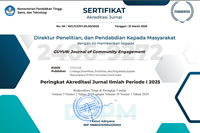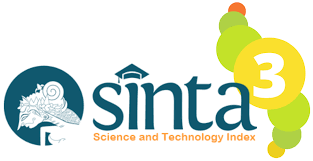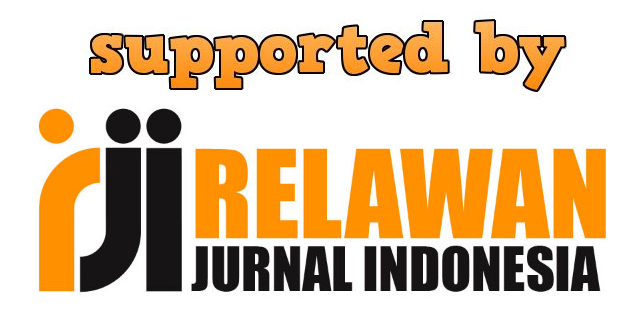Adiyono, A., Hayat, E. W., Oktavia, E. D., & Prasetiyo, N. T. (2024). Learning interaction in the digital era: Technological innovations and education management strategies to enhance student engagement. Journal of Research in Instructional, 4(1), 205–221. https://doi.org/10.30862/jri.v4i1.333
Cavert, M. S. (2020). Why Flip the Medical Resident Classroom? A Pilot Study in Singapore. Springer Singapore. https://doi.org/10.1007/978-981-15-4171-1
Chairiyah, S. S., Hanifah, E., Rotua, E., Sitorus, B., & Khayati, N. (2024). Analisis Strength , Weakness , Opportunities , and Threats dalam Perencanaan Peningkatan Mutu Pendidikan di Madrasah Tsanawiyah. Edukatif : Jurnal Ilmu Pendidikan, 6(5), 6183–6196. https://doi.org/10.31004/edukatif.v6i5.7636
Direktorat Sekolah Dasar. Dikjen PAUD, P. M. (2021). Menyiapkan Pendidik Profesional di Era Society 5.0. Kemendikbud Ristek. https://ditpsd.kemdikbud.go.id/artikel/detail/menyiapkan-pendidik-profesional-di-era-society-50
Dwi Astuti, R., Mahdalena Leksana, D., & Hida Febriani, N. (2023). Peningkatan Kompetensi Guru PAUD melalui Pelatihan MenciptakanEducational Cloth Book. Amalee : Indonesian Journal of Community Research and Engagement, 4(1), 283–292. https://doi.org/10.37680/amalee.v4i1.2090
Fajriyah, A., & Rindaningsih, I. (2024). Human Resource Management in Islamic Schools. Academic Journal Research, 2(1), 30–39. https://doi.org/10.61796/acjoure.v2i1.44
Farida, Y., & Rindaningsih, I. (2024). Analisis Sistematis Literatur tentang Transformasi Pelatihan dan Pengembangan Guru sebagai SDM pada Lembaga Pendidikan di Era Digital. Jurnal Akademik Ekonomi Dan Manajemen ", 1(4), 602–607. https://doi.org/0.61722/jaem.v1i4.3653
Findawati, Y., Rindaningsih, I., & Hastuti, W. D. (2021). Development of Flipped Learning Based on Android for Elementary School. Proceedings of the 1st Annual International Conference on Natural and Social Science Education (ICNSSE 2020), 547(Icnsse 2020), 362–365. https://doi.org/10.2991/assehr.k.210430.055
Fitrianingtyas, A., Zuhro, N. S., Jumiatmoko, Nurjanah, N. E., & Sholeha, V. (2021). Efektivitas Pelatihan Pembuatan Video Pembelajaran Menggunakan Smartphone bagi Pendidik PAUD. Murhum : Jurnal Pendidikan Anak Usia Dini, 2(2), 28–37. https://doi.org/10.37985/murhum.v2i2.48
Haryanto, B., Fahyuni, E. F., & Alimova, M. T. (2023). Branding Matters: Private Islamic Schools Struggle to Attract Students Under Educational Zoning. Atlantis Press SARL, 1, 313–321. https://doi.org/10.2991/978-2-38476-048-0_36
Heiss, E. M., & Oxley, S. P. (2021). Implementing a flipped classroom approach in remote instruction. Analytical and Bioanalytical Chemistry, 413(5), 1245–1250. https://doi.org/10.1007/s00216-020-03147-w
Kamila, H. N., Faslah, R., & Sholikhah. (2023). The Use of Online-Based Flipped Classroom Learning Models in Increasing Student Interest and Learning Outcomes. Jurnal Pendidikan Ekonomi, Perkantoran Dan Akuntansi, 4(1), 205–218. https://doi.org/10.21009/JPEB.007.2.3
Kemendikbud. (2022). Pedoman Umum Penyelenggaraan Pendidikan Anak Usia Dini Berkualitas. Kementerian Pendidikan, Kebudayaan, Riset Dan Teknologi, 1, 79.
Khayati, N., Rohma, S., & Santyani, Wi. (2025). Inovasi Model dan Strategi Pembelajaran Flipped Learning dalam Pendidikan Anak Usia Dini. Kumara Cendekia, 13(1), 80–89. https://doi.org/10.20961/kc.v13i1.95300
Kusumawati, E. (2022). Analisis SWOT Faktor Penyebab Penurunan Jumlah Peserta Didik Lembaga PAUD di Kabupaten Bogor. Tarbiatuna: Journal of Islamic Education Studies, 2(2), 88–96. https://doi.org/10.47467/tarbiatuna.v2i2.660
Latifah, U., & Rindaningsih, I. (2023). Implementasi Flipped Classroom dalam Mendukung Merdeka Belajar untuk Meningkatkan Kemandirian Belajar. Jurnal Papeda: Jurnal Publikasi Pendidikan Dasar, 5(2), 156–166. https://doi.org/10.36232/jurnalpendidikandasar.v5i2.4447
Lee, K., & Lai, Y. (2017). Facilitating higher-order thinking with the flipped classroom model: a student teacher’s experience in a Hong Kong secondary school. Research and Practice in Technology Enhanced Learning, 12(1), 8. https://doi.org/10.1186/s41039-017-0048-6
Miranti, Y. S., Syamsuddin, M. M., & Fitrianingtyas, A. (2021). Analisis Manajemen Pendidikan Anak Usia Dini Menggunakan Metode Evaluasi Swot Di Paud It Nur Hidayah. Kumara Cendekia, 9(4), 243. https://doi.org/10.20961/kc.v9i4.54966
Moraros, J., Islam, A., Yu, S., Banow, R., & Schindelka, B. (2015). Flipping for success: Evaluating the effectiveness of a novel teaching approach in a graduate level setting. BMC Medical Education, 15(1), 1–10. https://doi.org/10.1186/s12909-015-0317-2
Munafiah, N. (2020). Perencaan Strategik Melalui Analisis SWOT Di Tkit At-Taqwa Grabag Magelang. … Athfal: Jurnal Pendidikan Islam Anak Usia Dini, 4(2), 148–159. https://doi.org/10.19109/ra.v4i2
Nasrullah, M., & Rindaningsih, I. (2023). Improving Educator Recruitment Management in Primary and Secondary Education Institutions. Middle European Scientific …, 32, 71–80. https://doi.org/10.47494/mesb.v32i.1658
Nikitova, I., Kutova, S., Shvets, T., Pasichnyk, O., & Matsko, V. (2020). “Flipped learning” methodology in professional training of future language teachers. European Journal of Educational Research, 9(1), 19–31. https://doi.org/10.12973/eu-jer.9.1.19
Nouri, J. (2016). The flipped classroom: for active, effective and increased learning – especially for low achievers. International Journal of Educational Technology in Higher Education, 13(1). https://doi.org/10.1186/s41239-016-0032-z
Rindaningsih, I., Arifin, B. U. B., & Mustaqim, I. (2023). Empowering Teachers in Indonesia: A Framework for Project-Based Flipped Learning and Merdeka Belajar. Proceedings of the International Conference on Intellectuals’ Global Responsibility (ICIGR 2022), 1, 177–184. https://doi.org/10.2991/978-2-38476-052-7_20
Rindaningsih, I., Arifin, B. U. B., & Mustaqim, I. (2023). Empowering Teachers in Indonesia: A Framework for Project-Based Flipped Learning and Merdeka Belajar (Vol. 1). Atlantis Press SARL. https://doi.org/10.2991/978-2-38476-052-7_20
Rindaningsih, I., Findawati, Y., Hastuti, W. D., & Fahyuni, E. F. (2021). Synchronous and Asynchronous With Flipped Learning Environment in Primary School. PrimaryEdu - Journal of Primary Education, 5(1), 33. https://doi.org/10.22460/pej.v5i1.1883
Rindaningsih, I., Hastuti, W. D., & Findawati, Y. (2019). Desain Lingkungan Belajar yang Menyenangkan Berbasis Flipped Classroom di Sekolah Dasar. Proceedings of the ICECRS, 2(1), 41. https://doi.org/10.21070/picecrs.v2i1.2452
Tomas, L., Evans, N. (Snowy), Doyle, T., & Skamp, K. (2019). Are first year students ready for a flipped classroom? A case for a flipped learning continuum. International Journal of Educational Technology in Higher Education, 16(1). https://doi.org/10.1186/s41239-019-0135-4
Wolff, B., & Girnat, B. (2024). Student perspectives on the flipped classroom concept in secondary math lessons. Discover Education. https://doi.org/10.1007/s44217-024-00287-4
 (Universitas Muhammadiyah Sidoarjo)
(Universitas Muhammadiyah Sidoarjo) 









.png)
